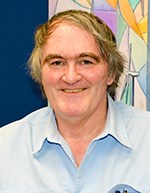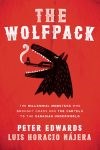Tracing the cocaine route from South America to southern Ontario
Journalist Peter Edwards calls them “millennial mobsters,” a loosely connected, tech-savvy band of underworld players age 35 and younger, who smuggled cocaine into Canada for Joaquín “El Chapo” Guzman’s multi-billion dollar Sinaloa cartel.
Given Niagara’s proximity to the American border, it is not surprising that a bunch of local entrepreneurs, calling themselves the “Wolfpack Alliance,” saw an opportunity to enrich themselves. Murder was just part of the bargain.
Edwards sat down with the Voice last week to discuss his book, “The Wolfpack,” the first major work that focuses on the links between Canadian and Mexican organized crime. The book has just been released by Random House Canada.
Although most of the drug gangsters depicted in his book are currently serving prison sentences, the flow of cocaine and other illicit substances into Canada continues unabated.

“I thought that the pandemic might really hurt these guys, but it didn't at all,” said Edwards. “These drug traffickers are really good at what they do. They don't look at it as a crime, it's simply how they survive.”
When he first began researching his story, Edwards believed that only a handful of cartels were in competition in the drug trade, but he soon learned that an exponentially larger number of splinter groups were involved, sometimes forming alliances to maximize on profits. But it is a risky business.
“If criminals join forces, they benefit from each other’s strengths, but they also get the other guy’s enemies,” said Edwards.
The felons came from diverse backgrounds. Some lived in nice, middle-class neighbourhoods, with parents holding professional jobs.
“They grew up as kids craving attention, who wanted to be rock stars, but didn’t really have any skills,” said Edwards. “They displayed an overwhelming sense of entitlement. Through their drug associations, they became more interesting to girls who are out of their league.”
Niagara drug kingpin Nick Nero, from Niagara Falls, figures prominently in Edward’s book. He was arrested for trafficking $30 million worth of cocaine, the largest seizure in Niagara history, and is serving time in prison as the mastermind behind the killing of Toronto gangster Johnnie Raposo and three other men.
Raposo was gunned down in a targeted hit in June of 2012, as part of a plot to steal his 200-kilogram shipment of cocaine. Trigger-man Dean Wiwchar, Nero, Rabih Alkhalil, and Martino Caputo were all charged with first-degree murder and conspiracy to commit murder.
Police built their case by analyzing the mobsters’ Blackberry smartphones, thanks to a password scribbled on a sticky note that Nero, an amateur bodybuilder who trained to be a wrestler, had inadvertently left unattended. Authorities found email messages that showed communication between all four of the accused leading up to the shooting.

Prior to the murder of Raposo, Nero had been confined to a St. Catharines halfway house during the week, the result of a prior conviction for the heist of an armoured car in Toronto in December of 2003. Nero’s share of the loot — about $1 million — remained missing, and when the courts tried to collect, Nero pleaded poverty (despite the fact that he drove a red Ferrari to and from the halfway house).
Prior to his conviction, Nero had connected with Zavisa “Zav” Drecic, a full-patch motorcycle club member from Welland, who was a conduit for Nero to rub shoulders with the Hells Angels and well-established mafiosi in his drug trafficking enterprise.
Many drug-dealing motorcycle gang members that Edwards met and interviewed had been touched by violence early in their lives, and were a product of their environment.
“A lot of these guys, as kids, had seen their mothers beaten by their fathers, and their thinking was ‘When I'm 17, this isn't going to happen anymore.’ A lot of them were rebelling against their father, and mad at authorities because they didn't protect their mother.”
Edwards said that it was very rare to see a Hells Angel combination involving a father and a son, “but with the mob, you always get a lot of that.”
Drug-dealing motorcycle club members, interviewed for his book, weren't apologetic about what they did, said Edwards.
“I told then, don't tell me anything you don't want to see in print, because I'm not your priest or your shrink.”
I told then, don't tell me anything you don't want to see in print, because I'm not your priest or your shrink
The worst thing for them is betrayal, said Edwards, and the ultimate insult is being called a conniver or a weasel.
Unlike the Hell’s Angels, who have a highly structured organizational stratification, the millennial mobsters were much more loosely associated.
“The smartest guy would be the dominant one, but they wouldn't actually have a title,” said Edwards, who is hoping that his book might spawn a TV or movie deal.
“I’m hoping for television interest,” said Edwards. “It sounds really crass, but if it's a film, it's a one-shot deal, whereas a TV series can go on forever.”
Mid-level drug smugglers could earn $150,000 a month, but lived in constant fear of challenges and lethal hits from rival gangs.
“It’s easy to find out where a guy lives,” said Edwards. “You just attach a magnetic GPS tracking device to his car while he’s in a bar, and wait for him to drive it home.”
Niagara’s location close to the American border makes it perfectly situated for drug trafficking.
“The cartels are active in Chicago, which isn't that far from Buffalo, and Buffalo is just a blink of an eye from here,” said Edwards.
The book also details a cocaine trafficking sweep by police, dubbed “Project Roadmaster,” in 2014, which netted Jeffrey Kompon of Welland, Laurence Aiello of Fort Erie, and Guy Caputo of Fonthill. A search warrant for a warehouse in rural Port Colborne resulted in the discovery of cocaine sealed inside large stone boulders that were imported from Mexico. All men were given prison terms.
Asked if casinos are used by the mob to launder illegitimate money, Edward’s responded, “I think so. But if I was laundering money, I’d put it into condos in Toronto or Vancouver.”
Edwards is the bestselling author of 15 non-fiction books, and the first-ever beat reporter on organized crime for the Toronto Star. He is also executive producer for the CityTV series “Bad Blood,” based on his book “Business or Blood: Mafia Boss Vito Rizzuto's Last War.” Rizzuto was a Montreal-based crime boss who led the Sicilian mafia in Canada, whose death in 2013 prompted other druglords and millennial mobsters to make a play for his lucrative ventures.
He worked on his book with fellow journalist Luis Horacio Nájera, who had been a newspaper reporter in Juarez, Mexico (a region Edwards refers to as a “war zone”) where he covered smuggling, corruption, and the drug trade. Threats from the cartel caused him to flee to Canada.
Is he fearful of repercussions from the underworld for his tell-all?
“Not really,” said Edwards with a shrug. “Working for a big newspaper like the Toronto Star, it would generate a lot of negative attention if something happened to me.”
Then he added, with a laugh, “but I wouldn't mind you starting my car for me.”


